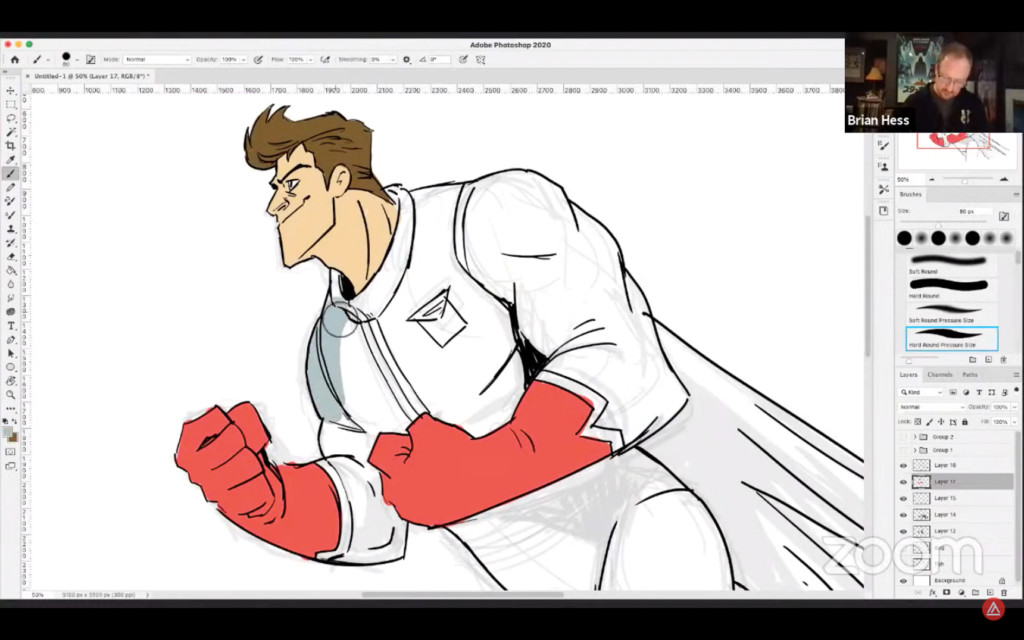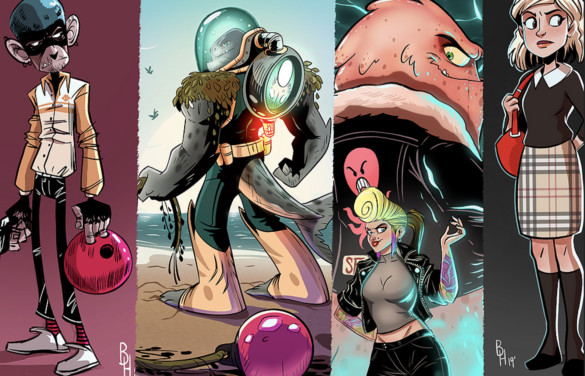By Greta Chiocchetti
With each pen stroke, a burly, perfectly coiffed superhero slowly comes to life.
Drawing live from his Wacom Cintiq over Zoom, Academy of Art University School of Game Development (GAM) Associate Director Brian Hess showed students how to transform an idea into a vibrant, lifelike character. Hess is a character designer, illustrator, and art director who has worked for Zynga, Thrasher Magazine, and TinyCo. He joined GAM Executive Director David Goodwine during a recent webinar to demonstrate the skills he’s refined throughout his career and to share how both current and prospective students could harness those same skills themselves.
“I ask myself, ‘What does this character do? What’s his purpose, his game plan?’” said Hess, starting with a rough sketch of the burly hero. He added definition and shadows with masterful pen strokes as he and Goodwine answered live audience questions. The first question came from an aspiring art student who wondered what foundational skills they’d need as an entering GAM student.
As freshmen and sophomores, most students take the same foundational art classes, which give them the tools to move forward, Goodwine said. Once students break off into their majors, they start taking courses specific to their chosen area. “If you’re going to be a game designer, you’re going to take classes that are more focused in level design, game theory, and how do I make this game fun, all the mechanics that go into that,” explained the GAM director.
As Hess began adding splashes of color to his sketch—bright red to his hero’s cape and gloves, a warm rust orange sky as the backdrop—he answered a question about how to avoid discouragement and burnout as an early-career artist.
“I get burnt out all the time,” Hess said. “Just being honest. I’m burnt out right now. I’m working on two books that are going into publication; I’m teaching, I’m working on a video game, I’m a dad, I’m married … I’ve got all this stuff going on. But the reason it doesn’t bother me is because I love doing this stuff. I love creating something new and building on it, and seeing people enjoy it. It gives me a lot of joy.”

“In terms of getting discouraged, that’s something that happens with everybody. That’s going to happen to you your entire career,” Hess continued. “The minute you feel like you’re getting ahead with your skills, you’re going to look across the aisle or see someone on the internet who’s doing better than you are—and that happens—but your skills are going to grow your whole career and your whole life, and if this is something that you’re passionate about, it’s just going to keep happening to you. It needs to be a full-time commitment; this isn’t something that you just kind of passively do. You can get discouraged really quickly, or you can take that and turn it around and feed off of it.”
No matter the chosen area of focus, Goodwine added, burnout is a part of being in the creative industry.
“There’s always going to be burnout. It just matters how you handle it,” said Goodwine. “Sometimes, you need to step away and do something else. I’ve done that in the past, just gone for a drive or run, and usually I come up with another solution.”
As Hess transformed the monochromatic orange backdrop behind his hero into the layered, textured surface of planet Mars, he discussed how he developed his personal style.
“I’m inspired by different things than David is, for example,” said Hess. “My style is inspired by Disney, but also the comics I grew up with: X-Men, “Batman: The Animated Series” … Being inspired by other artists builds this amalgamation of style that you eventually become. I ask my students, ‘What are you inspired by?’ and we go through their art and ask what we can pull out of that style—what elements can we incorporate (without copying the artist but borrowing what they find interesting)?”
But despite an artist’s style, Hess said, it’s essential to be flexible enough to work in whatever style the studio requires for a particular project.
“Ninety-nine percent of the time, you will not be drawing what you want to be drawing,” Hess said. “You will always be drawing whatever game comes up, whatever the project is. What we’d like to do in the department is try to get you guys ready for what it’s going to be like to work in a studio.”
Just as he added the finishing touches to his drawing—alien spaceships complete with laser beams—Hess answered a question about knowing when to call a piece finished.
“You just kind of get a feeling for it, but you also get to the point where you have a producer, you have a deadline, and you just need to stop,” said Hess. “I get kind of obsessed with whatever it is that I’m working on, and it’s hard to let stuff go. But you have to be on time.”
Watch the Learning to See webinar in full below.
